- Home >
- Topics
Topics of No.21 (September, 2025)
[Bangladesh]
Functional Bridge Symbolizing the Friendship Between the Two Nations
Bangladesh, which borders India and Myanmar, is a hub for international trade. Yet, many of its cross-border roads and bridges have deteriorated, reducing their effectiveness as logistics arteries. About 70% of passenger and freight transport in Bangladesh relies on roads, so aging bridges pose a serious bottleneck and require urgent improvement. Oriental Consultants Global is helping address this issue through the Bangladesh Cross-Border Road Network Improvement Project, which will replace or construct about 20 bridges on key routes linking the country with its neighbors.
As part of this project, Oriental Consultants Global completed the Madhumati Bridge (also known as the Kalna Bridge) in October 2022. This six-lane road bridge is 690 meters long. Its main span employs a steel Nielsen-Lohse arch, commonly used in Japan but applied here for the first time in Bangladesh. The bridge today symbolizes the nation’s friendship with Japan.
Before its opening, no bridge served this stretch of river. Ferries handled all crossings. Growing traffic driven by economic development increasingly overwhelmed that service, leading to long waiting and crossing times. The Madhumati Bridge has cut crossing times to just a few minutes and improved transport and logistics networks among major cities. This should spur trade with neighboring countries and support economic growth across South Asia.
Oriental Consultants Global received the Japan Society of Civil Engineers Technology Award (Category II) in June 2024 in recognition of its achievement.
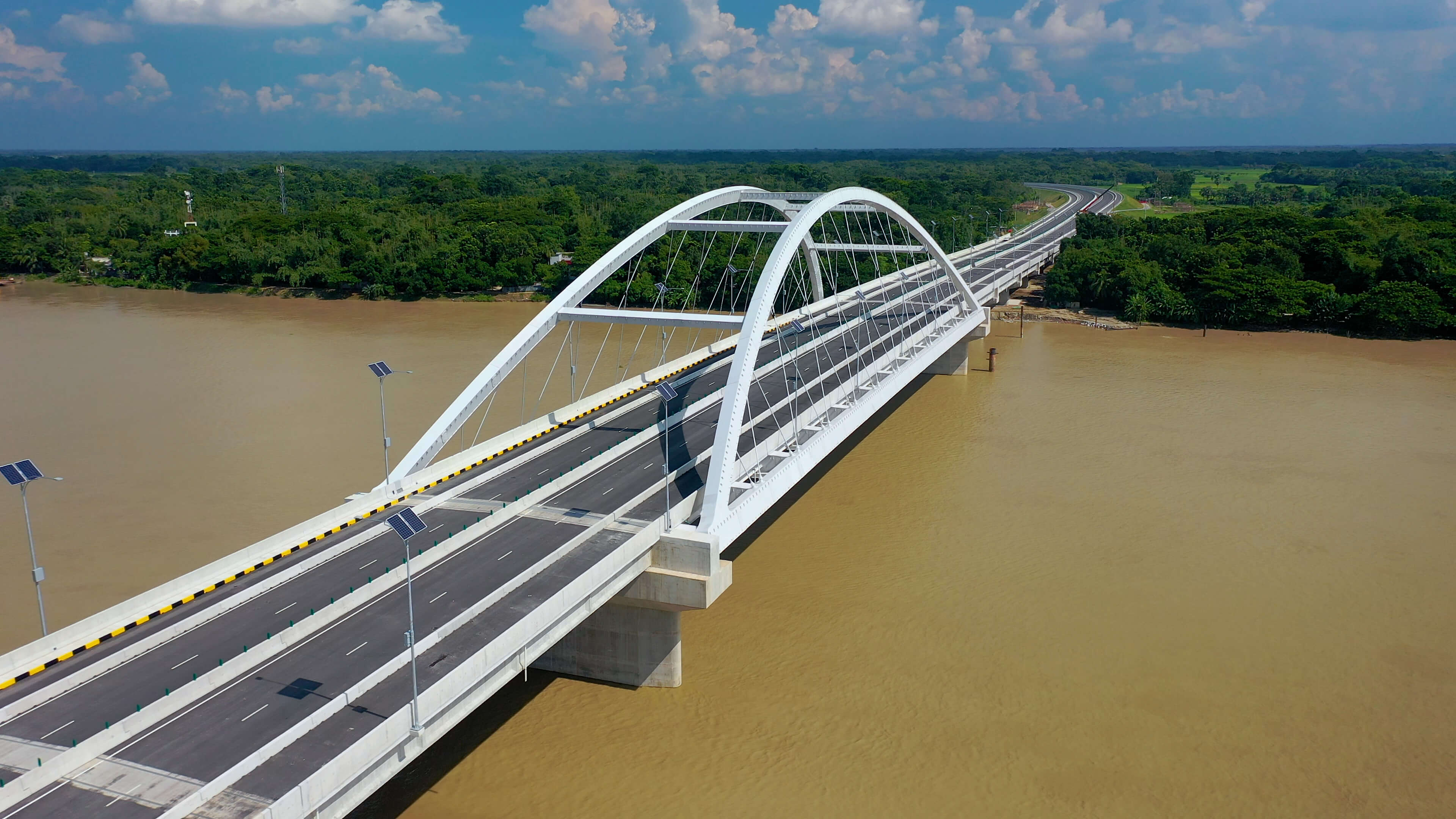
Incorporating what is a structural first in Bangladesh, the Madhumati Bridge symbolizes the nation’s friendship with Japan
[India]
Water Supply and Sewerage Project to Save “India's Silicon Valley”
Bengaluru, formerly known as Bangalore, is essentially India’s Silicon Valley. Rapid industrial development and population growth have expanded the metropolitan area and driven up water demand. At the same time, water supply and sewerage infrastructure have not kept pace, causing chronic water shortages and unsanitary living conditions.
Oriental Consultants Global is helping address these issues through Phase 3 of the Bangalore Water Supply and Sewerage Project. This joint venture with three other companies is backed by about ¥80 billion in Japanese overseas development loans.
The project increases water supply by drawing from the Kaveri River, about 70 kilometers from Bengaluru, and constructing a new water treatment plant and transmission pipelines nearby. It is also expanding distribution networks to supply districts that lack piped water while constructing sewage treatment plants.
The water treatment facilities, pumping stations, and monitoring and control systems use technologies from Japanese companies, including Toshiba Water Solutions Private Limited, Kubota Corporation, Torishima Pump Mfg. Co., Ltd., and Mitsubishi Electric Corporation. These efforts should improve sanitation for local residents and support further industrial development.
The city hosts many Japanese companies, particularly in manufacturing and IT. Among them are Toyota Motor Corporation and Rakuten Group, Inc. The new facilities should also bolster their activities.
Oriental Consultants Global will continue to improve sanitation and support industrial and economic development in India through water and sewerage infrastructure projects.
Water treatment facilities at this site employ a stepped cascade design
Participating in Public Transport Initiative Connecting Towns through AI-Based System
We took part in a pilot project that ran from October 2024 through January 2025 to provide transportation between the towns of Taki and Meiwa in Mie Prefecture through a reservation-based system. The Ministry of Land, Infrastructure, Transport and Tourism selected this initiative for its Co-creation and MaaS Demonstration Project.
While many residents need to travel between the two towns to reach medical facilities and commercial centers, no public transportation connects them. This has created mobility challenges for seniors who have surrendered their driver’s licenses and for people with disabilities who have difficulty obtaining one.
The pilot project set up a transfer point near the boundary between the two towns. It used AI to link their demand-response services and enabled transfers at that point. Residents thereby gained access to transportation within a shared regional living area crossing municipal lines.
Oriental Consultants Co., Ltd., managed the demonstration, designed the system, handled publicity and surveys, and compiled the results. It will review the findings and work toward deploying a sustainable public transportation service.
Transfer point outside Dew Point salon at DC Mall Kongozaka shopping center for transportation services between two towns
Deploying Digital Technologies for Urban Services ahead of Opening of Maglev Services
In 2023, Oriental Consultants, Aisan Technology Co., Ltd., and Intelligence Design Inc. concluded a collaborative agreement with the city of Iida to deploy digital technologies for urban services to prepare for the launch of maglev line services connecting Tokyo with Nagoya and ultimately Osaka. They have undertaken a range of related urban development initiatives.
In April 2024, for example, a Level 2 autonomous EV bus trial was conducted in Iida’s central business district as part of efforts to develop urban and regional public transportation services once the maglev line is operational. The bus ran between three stops in the city center, to test the technical and social viability of such a service. In March 2025, Oriental Consultants exhibited in a regional event to exchange digital transformation ideas. It presented three technologies to the Minami-Shinshu region. The first was a virtual reality goggle-based driving and pedestrian experience to highlight virtual traffic safety measures. The second was to confirm changes in views through building height adjustments in cyberspace, improve roads to make them more pedestrian-friendly, and visualize people and vehicle flows with live camera footage. The third was to visualize autonomous bus location information in cyberspace. These were presented to the residents of Minami-Shinshu.
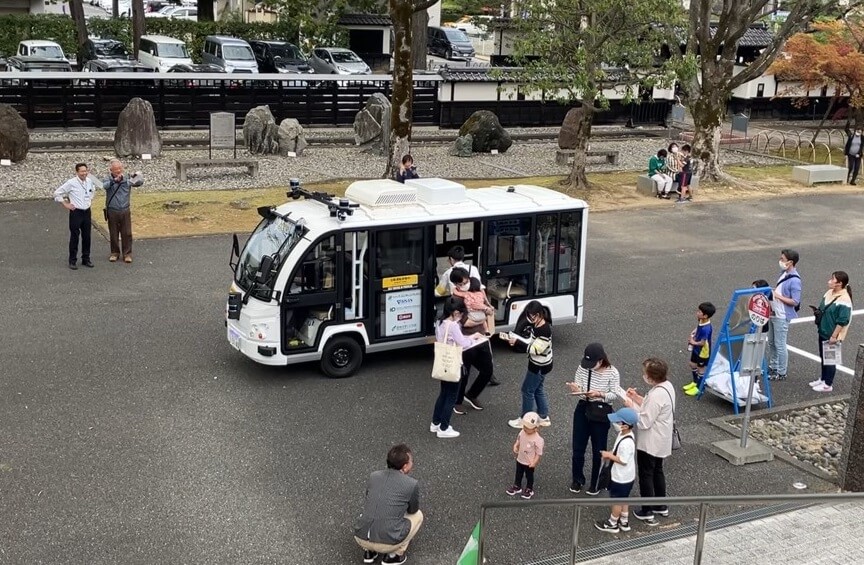
The autonomous bus trial was very well received
AI-Based Traffic Accident Analysis Wins Excellence Award in Infrastructure DX Awards
Conventional traffic accident analysis entails personnel going to accident sites to observe traffic flows and infer why crashes occur. This process relies heavily on individual judgment and is slow and somewhat inaccurate.
Oriental Consultants deployed an AI-based traffic analysis method to address this issue. The system records the movements of vehicles, bicycles, and pedestrians on video and uses AI to automatically and objectively identify hazardous situations. In the example shown in the upper-right figure, the AI analyzes the speeds and relative positions of a car and a bicycle as they approach each other and predicts that they will collide in 1.24 seconds if neither takes evasive action.
This video-based approach reveals accident mechanisms that conventional methods could not capture and supports the design of more effective countermeasures. It also cuts analysis time to about one-fifth of traditional field observation, enabling much faster analysis. The Ministry of Land, Infrastructure, Transport and Tourism recognized this method with the Excellence Award in the Construction and Operations category of the Fiscal 2022 Infrastructure DX Awards.
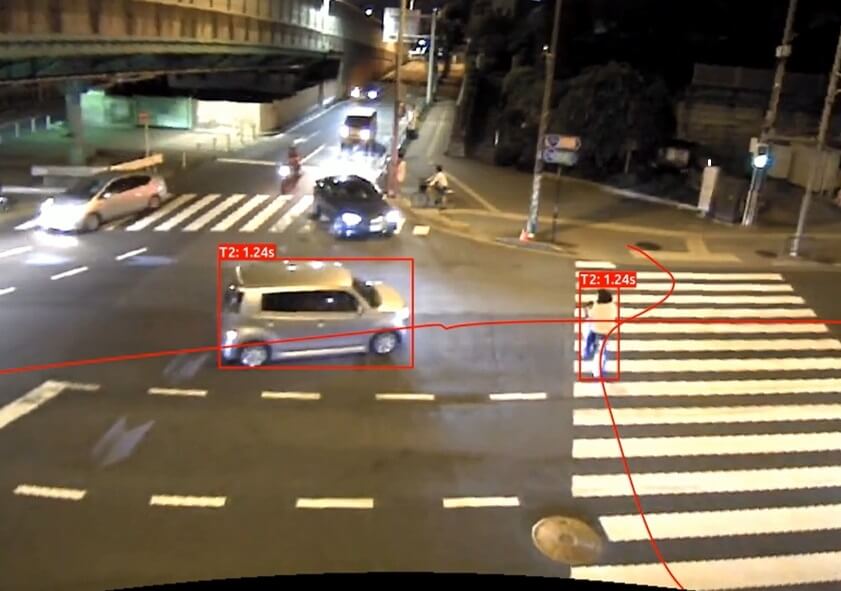
AI uses video footage to predict collision time
Researching Transportation Management Digitization Technologies Worldwide to Resolve Transportation Challenges in Developing Countries
In many developing countries, chronic congestion, frequent accidents, and other traffic management issues are getting worse. Against this backdrop, the Japan International Cooperation Agency (JICA) has supported improvements in traffic management, including by introducing intelligent transportation systems. Significant challenges nonetheless remain in sustaining these systems. Examples include tailoring systems insufficiently to local traffic conditions and using facilities and equipment that are not mutually compatible.
To address these issues, JICA commissioned Oriental Consultants Global Co., Ltd., to survey traffic management digitalization technologies worldwide. This one-year project through February 2025 produced recommendations to guide JICA’s future traffic management policies.
The project included field surveys in Japan and in other developed and developing countries. The final report set out recommendations in seven key areas, including effective approaches to technology development in developing countries and research on advanced traffic management systems. JICA expects to draw on these findings when considering future traffic management initiatives.
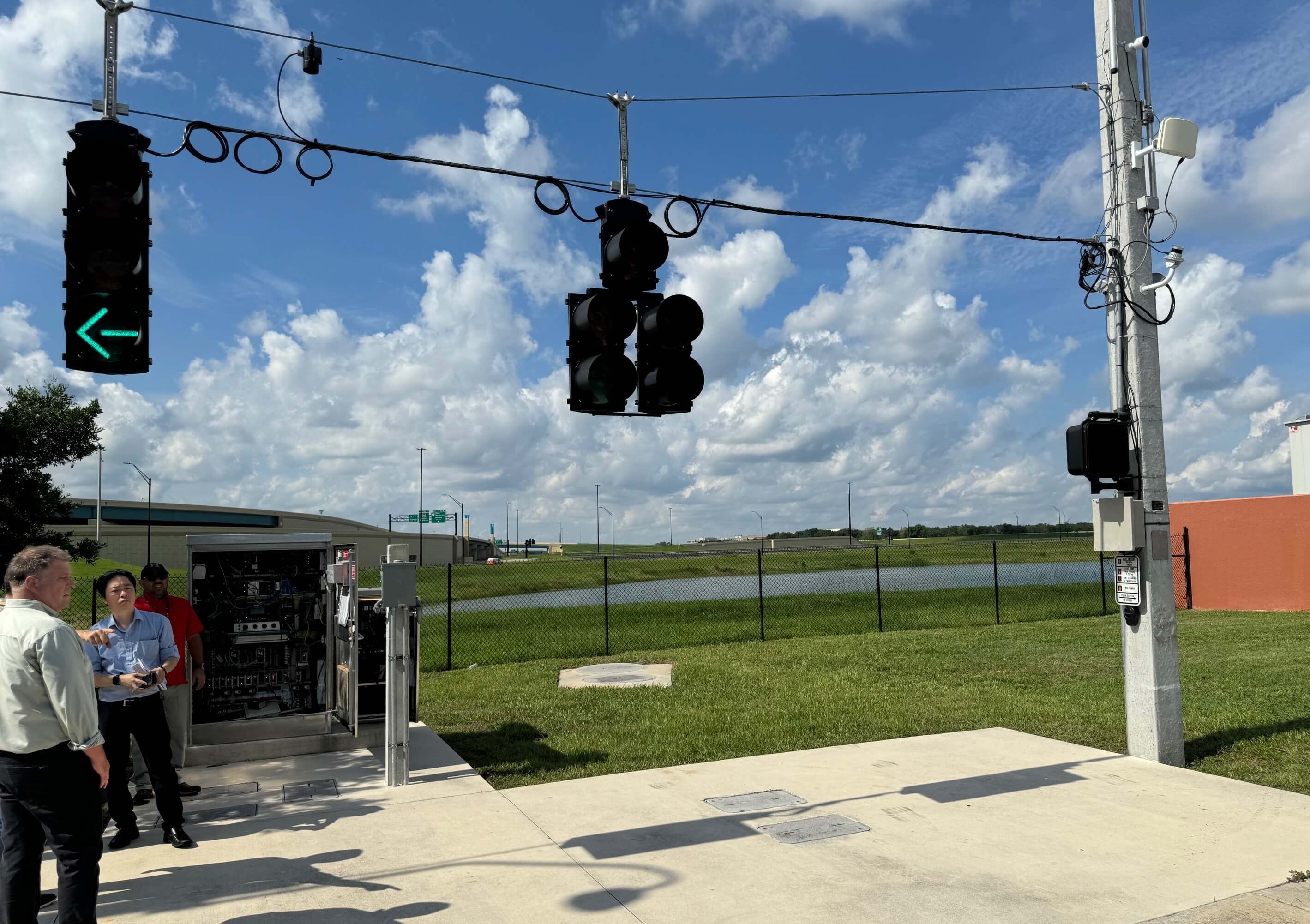
Oriental Consultants Global tested traffic signal control systems in the United States
Using Real-Time Traffic Information to Test Effectiveness of Rear-End Collision Warning Systems
The Ministry of Land, Infrastructure, Transport and Tourism commissioned Oriental Consultants and A-TEC Co., Ltd., to study traffic safety measures in Mie Prefecture over a year through March 2023. In analyzing fatal and injury accidents within the prefecture they found that rear-end collisions accounted for more than half of all accidents. They also learned that around 30% of these incidents were at major congestion points.
These findings prompted them to research, develop, and field test a rear-end collision warning system harnessing information and communication technology at these points. MOVTRA portable traffic counters employed their infrared sensors to detect vehicles passing through the locations around the clock. A-TEC-developed MOVTRA to measure traffic volume and speeds. It displays real-time warnings on an information board when detecting speed reductions.
This initiative found that there were fewer sudden decelerations on routes where congestion levels remained similar before and after board deployments. A questionnaire revealed that more than 50% of drivers noticing the boards became more attentive. The two companies will improve the technology and explore its usefulness in easing traffic congestion.
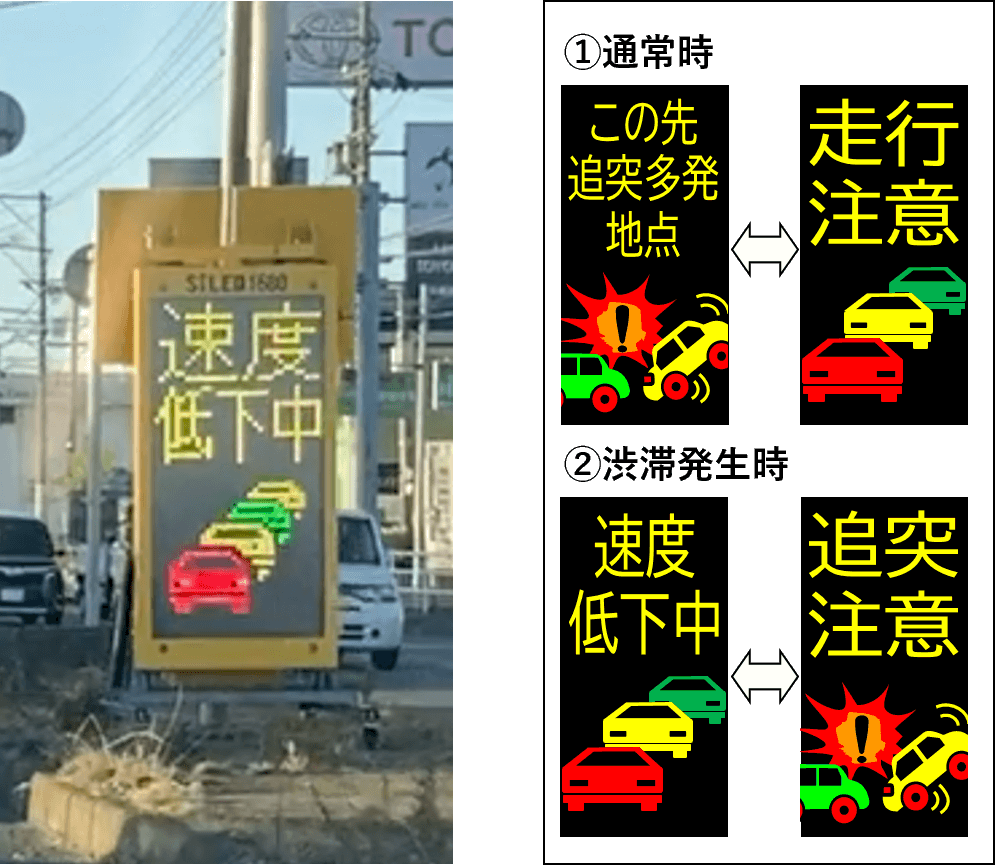
Information board installed on National Route 23
Visualizing Driving Behavior by Combining AI and Professional Consulting to Help Companies Prevent Traffic Accidents
Simply installing dashcams is not enough to prevent traffic accidents. The most effective approach is to provide ongoing guidance that strengthens drivers’ safety awareness, while leveraging the latest technology and embedding safe practices in corporate culture. To address this challenge, Research & Solution Co., Ltd. and GO Inc. equipped company fleets with Sherlock Pro, an AI-based dashcam system. Its AI identifies habitual unsafe driving and regularly provides feedback and improvement tips to drivers.
Sherlock Pro is designed to keep raising safety awareness and anchor it in corporate safety practices. It uses AI to recognize vehicles ahead and drivers’ faces. It visualizes such risky behaviors as using smartphones while driving, ignoring stop signs, speeding, and tailgating. It issues alerts as needed to prompt corrective action.
Many companies that introduce dashcams still fall short of their safety goals because they lack the internal resources or operational knowhow to use them effectively. Research & Solution and GO support clients from implementation through day-to-day operation, help strengthen corporate safety management, and provide services that assist companies until safety awareness takes root.
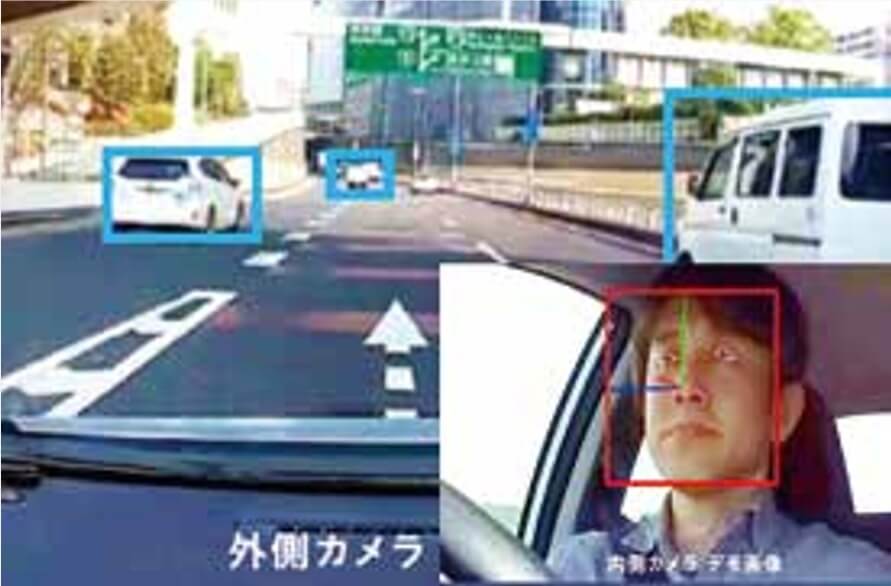
AI detects hazardous situations

